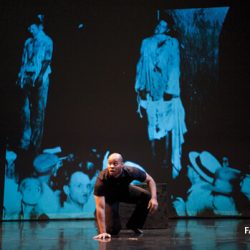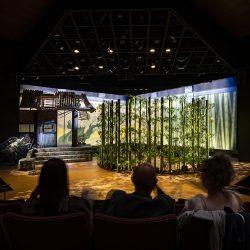Where to stage a lynching

Theater (or is it theatre?) professor Patrick Sims rehearses for a production of Ten Perfect, his one-man show. Photo: Jeff Miller
Watching Ten Perfect was a bit of a shock for me.
When I went to see Patrick Sims perform his one-man show (research for “How to Stage a Lynching,” which starts on page 22, if you’re interested), I was prepared for a lot of things — racism, violence, strong language, adult situations. What I wasn’t prepared for was the venue. It was staged in Lathrop Hall.
There’s a theater in Lathrop Hall?
Don’t be fooled — there actually isn’t a theater there. Not technically, because technically, Lathrop’s stage is in a “performance space” — officially the Margaret H’Doubler Performance Space, named for the university’s legendary dance instructor. It seats 240, meaning that it’s big enough to hold all the people in the world who can correctly pronounce “H’Doubler” and still leave 239 empty chairs.
It turns out, the UW really has only two theaters: the Union Theater, which is the largest venue on campus, and the Fredric March Play Circle Theater, also in Memorial Union. But it also has two theatres, Mitchell Theatre and Hemsley Theatre, both of which are in Vilas Hall. I don’t know why they’re spelled that way. Maybe they were built by Anglophiles. Or maybe they take their lead from University Theatre (which is an organization, not an edifice — it’s the group that puts on the bulk of the shows in Vilas Hall’s venues) or from the Department of Theatre and Drama. (I like this spelling bettre, but my editro disagrees.)
The point is, the university actually has more stages than the ones in its theaters and theatres. In addition to the “performance space” in Lathrop, there’s another one (called the Galleries and Performance Space) in the new Arts Loft. The Humanities Building houses three halls — Mills, Morphy, and the Eastman Organ Recital Hall, in any of which you might catch a show at the right time. And Music Hall has a stage, too, but it’s called the Carol Rennebohm Auditorium.
These places could, altogether, stage ten different performances all at once, to entertain more than 3,500 people. That’s a lot of drama, no matter what you call the room in which you see it.
Published in the Fall 2010 issue



Comments
No comments posted yet.